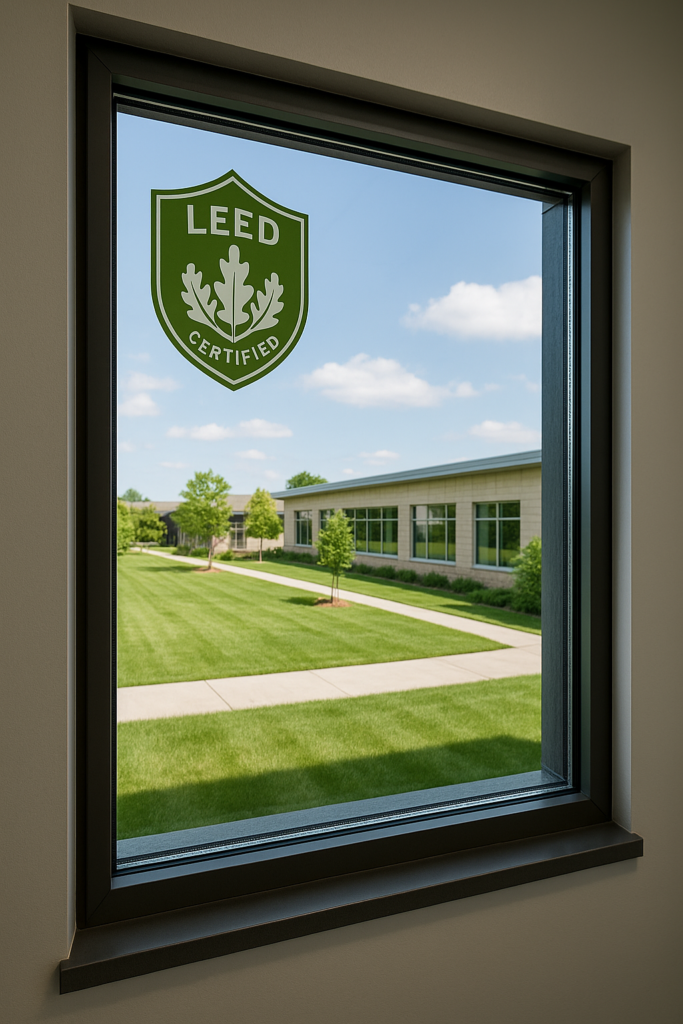Introduction: Glazing That Powers Sustainable Design
As environmental performance becomes a defining metric in architecture, specifying building materials that support green standards is more important than ever. A high-performance Insulating Glass Unit (IGU) plays a central role in achieving certifications like LEED, WELL, BREEAM, and Green Globes.
IGUs contribute to thermal efficiency, daylighting, acoustic control, and long-term sustainability—all of which are core pillars of green building rating systems. This article explores how IGUs help projects meet certification criteria while improving occupant comfort, energy savings, and architectural integrity.
What Is an Insulating Glass Unit?
An Insulating Glass Unit consists of two or more glass panes separated by a spacer, sealed to create an insulating cavity filled with air or inert gas (e.g., argon or krypton). IGUs often incorporate coatings, tints, or laminated layers for enhanced thermal, acoustic, and safety performance.
From envelope efficiency to visual comfort, IGUs support high-performance design from the façade inward.
How IGUs Align with Major Green Certifications
1. LEED (Leadership in Energy and Environmental Design)
The LEED rating system awards points across categories that IGUs directly influence:
- Energy & Atmosphere (EA): Low U-values and SHGC contribute to optimized energy performance
- Indoor Environmental Quality (IEQ): IGUs enhance daylighting and thermal comfort
- Materials & Resources (MR): Durable, recyclable materials reduce lifecycle impacts
2. WELL Building Standard
IGUs help meet WELL v2 performance features including:
- Thermal Comfort (T01–T05): By limiting temperature swings and draft zones
- Light (L03, L04): Supporting visual acuity, glare reduction, and circadian rhythm
- Sound (S01–S05): When paired with acoustic interlayers or Z-1 compositions
Explore acoustic performance in Insulating Glass Unit and Z-1 in Noise-Control Design.
3. BREEAM (Building Research Establishment Environmental Assessment Method)
BREEAM credits IGUs under categories such as:
- Hea 01 Visual comfort: For daylighting and glare control
- Ene 01 Reduction of energy use and carbon emissions: Through advanced insulation
- Mat 01 Life cycle impacts: Via long-life, recyclable components
4. Green Globes
Green Globes credits cover:
- Thermal resistance and air infiltration control
- Glare-free daylighting
- Low-emissivity coatings and gas fill options
Green Benefits of Insulating Glass Units
1. Energy Efficiency
IGUs reduce energy use by slowing heat transfer through façades and skylights. Options like triple glazing, low-E coatings, and warm-edge spacers optimize U-values and reduce HVAC demand.
2. Daylighting and Visual Comfort
High-VT (visible transmittance) IGUs maximize daylighting potential while controlling glare. This reduces reliance on electric lighting and supports cognitive performance.
3. Acoustic Control
IGUs with laminated or Z-1 layers offer noise mitigation without sacrificing natural light. This enhances comfort in dense urban, transit, or industrial settings.
Discover hybrid applications in Insulating Glass Unit Hybridized with Laminated Layers.
4. Solar Heat Gain Control
Spectrally selective coatings on IGUs allow visible light while rejecting infrared. This keeps interiors cool in summer and reduces load on mechanical systems.
5. Condensation and Moisture Control
Properly installed IGUs resist condensation, supporting healthy indoor air quality and limiting mold growth.
6. Material Sustainability
IGUs often include recyclable materials such as aluminum spacers, glass substrates, and eco-friendly sealants.
Recommended IGU Configurations for Certification Projects
| IGU Type | Description | Certifications Impacted |
|---|---|---|
| Double Low-E IGU | 6mm clear + 12mm argon + 6mm Low-E | LEED EA, WELL Thermal, BREEAM |
| Triple IGU with Krypton | 6mm Low-E + 12mm krypton + 6mm clear + 12mm + 6mm | Passive House, LEED Platinum |
| Laminated Acoustic IGU | 6.76mm laminated + 12mm argon + 6mm clear | WELL Sound, LEED IEQ, BREEAM |
| Z-1 Hybrid Impact IGU | 8mm Z-1 + 14mm krypton + 6.76mm laminated | LEED, WELL, Secure Building Credits |
Learn about impact performance in Insulating Glass Unit Featuring Z-1 for High Impact Zones.
IGU Applications That Support Sustainable Design
Educational Institutions
IGUs deliver safe, well-lit, acoustically balanced environments for learning and concentration.
Healthcare and Laboratories
Cleanable, quiet, thermally stable glass enhances patient healing and lab performance.
Government and Civic Buildings
IGUs help these facilities meet both energy targets and security codes.
Hospitality and Resorts
Energy-saving glazing maintains guest comfort in climate zones while allowing design freedom.
Landscape-Integrated Facilities
Natural daylight and protected views through IGUs create connection to nature without performance trade-offs. Learn more in Bright View Landscape Defined: What Makes It Stand Out?.
Installation and Maintenance for Long-Term Green Value
Insulating Glass Unit Installation
Correct Insulating Glass Unit installation is critical to maximize performance:
- Use thermally broken frames
- Maintain perimeter seal integrity
- Integrate with continuous air and vapor barriers
Insulating Glass Unit Maintenance
Maintenance is minimal but ensures performance over decades:
- Use non-abrasive, eco-safe cleaning agents
- Inspect edge seals annually
- Monitor for signs of fogging or inert gas depletion
Lifecycle and ROI Considerations
- Reduced Operational Costs: Lower HVAC and lighting energy consumption
- Extended Service Life: Many IGUs exceed 25–30 years with proper installation
- Certification Compliance: Simplifies documentation and verification for green certifying bodies
Conclusion: IGUs as Pillars of Sustainable Building
The Insulating Glass Unit is one of the most impactful components in a sustainable building envelope. With innovations like low-E coatings, triple glazing, Z-1 integration, and acoustic-laminated layers, IGUs enable projects to meet—and exceed—the requirements of the world’s leading green certification programs.
Whether you’re designing a high-rise, hospital, school, or nature pavilion, specifying high-performance IGUs ensures long-term performance, lower environmental impact, and occupant wellbeing—all aligned with the future of responsible building.

